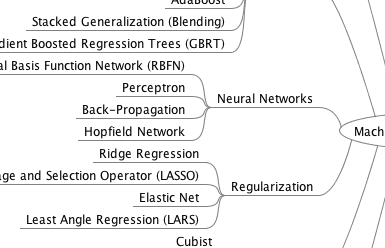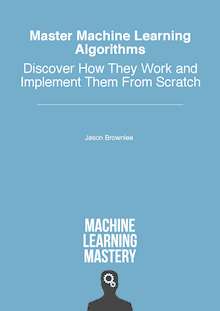What Questions Would You Ask to Learn About Machine Learning Model Characteristics
Final Updated on August 12, 2019
There are a lot of automobile learning algorithms and each algorithm is an isle of research.
You have to choose the level of detail that you study machine learning algorithms. There is a sweet spot if you are a developer interested in practical predictive modeling.
This post describes that sweet spot and gives you a template that you tin can use to quickly understand whatsoever machine learning algorithm.
Boot-start your projection with my new book Main Motorcar Learning Algorithms, including step-by-step tutorials and the Excel Spreadsheet files for all examples.

Sweetness Spot For Understanding Auto Learning Algorithms
Photograph past dmums, some rights reserved.
Permit'due south get started.
What You Need To Know About a Machine Learning Algorithm?
What practise you demand to know near a machine learning algorithm to be able to use information technology well on a classification or prediction problem?
I won't contend that the more that you know almost how and why a particular algorithm works, the improve you can wield it. Simply I do believe that in that location is a bespeak of diminishing returns where y'all tin stop, utilize what you know to exist effective and dive deeper into the theory and research on an algorithm if and merely if you need to know more in order to get better results.
Permit's accept a look at the 6 questions that will reveal how a car learning algorithms and how to best utilize it.
Get your FREE Algorithms Listen Map

Sample of the handy machine learning algorithms mind map.
I've created a handy listen map of 60+ algorithms organized by blazon.
Download it, print information technology and use it.
Besides get exclusive access to the car learning algorithms e-mail mini-course.
6 Questions To Ask Nigh Any Algorithm
There are 6 questions that you can ask to get to the center of any machine learning algorithm:
- How do y'all refer to the technique (e.m. what proper noun)?
- How practise you represent a learned model (e.k. what coefficients)?
- How to you learn a model (e.g. the optimization procedure from information to the representation)?
- How do yous brand predictions from a learned model (e.thou. employ the model to new data)?
- How do you all-time fix your data for the modeling with the technique (e.thousand. assumptions)?
- How do yous get more information on the technique (due east.g. where to look)?
You will note that I have phrased all of these questions as How-To. I did this intentionally to separate the applied concerns of how from the more theoretical concerns of why. I think knowing why a technique works is less important than knowing how it works, if you are looking to utilise it as a tool to get results. More than on this in the next section.
Let's take a closer look at each of these questions in turn.
1. How Do You Refer To The Technique?
This is obvious but important. You need to know the canonical name of the technique.
You need to be able to recognize the classical proper noun or the name of the method from other fields likewise and know that it is the aforementioned matter. This also includes the acronym for the algorithm, because sometimes they are less than intuitive.
This will help you sort out the base of operations algorithm from extensions and the family tree of where the algorithm fits and relates to like algorithms.
2. How Do You Represent a Learned Model?
I actually like this nuts and bolts question.
This is question oft overlooked in textbooks and papers and is mayhap the first question an engineer has when thinking about how a model will really be used and deployed.
The representation is the numbers and data structure that captures the distinct details learned from data by the learning algorithm to exist used by the prediction algorithm. Information technology's the stuff you save to disk or the database when y'all finalize your model. It's the stuff you update when new training data becomes bachelor.
Let's brand this concrete with an example. In the case of linear regression, the representation is the vector of regression coefficients. That's it. In the case of a decision tree is is the tree itself including the nodes, how they are continued and the variables and cut-off thresholds chosen.
3. How Exercise You Learn a Model?
Given some training data, the algorithm needs to create the model or fill in the model representation. This question is about exactly how that occurs.
Often learning involves estimating parameters from the grooming data straight in simpler algorithms.
In most other algorithms it involves using the preparation data as role of a cost or loss function and an optimization algorithm to minimize the function. Simpler linear techniques may utilise linear algebra to achieve this result, whereas others may use a numerical optimization.
Often the style a machine learning algorithm learns a model is synonymous with the algorithm itself. This is the challenging and oft fourth dimension consuming function of running a auto learning algorithm.
The learning algorithm may be parameterized and it is frequently a good thought to list common ranges for parameter values or configuration heuristics that may be used equally a starting indicate.
four. How Do You Make Predictions With A Model?
In one case a model is learned, information technology is intended to exist used to brand predictions on new data. Note, we re exclusively talking nigh predictive modeling machine learning algorithms for classification and regression problems.
This is often the fast and fifty-fifty trivial part of using a machine learning algorithm. Often it is so picayune that it is not even mentioned or discussed in the literature.
It may exist trivial considering prediction may be every bit simple as filling in the inputs in an equation and computing a prediction, or traversing a conclusion tree to run into what leafage-node lights upward. In other algorithms, like k-nearest neighbors the prediction algorithm may be the master show (thousand-NN has no training algorithm other than "store the whole training set up").
5. How Do You Best Prepare Data For The Algorithm?
Automobile learning algorithms make assumptions.
Even the almost relaxed non-parametric methods make assumptions most your training data. It is practiced or even disquisitional to review these assumptions. Even better is to interpret these assumptions into specific data training operations that you lot can perform.
This question flushes out transforms that you could use on your data earlier modeling, or at the very to the lowest degree gives you interruption to think well-nigh data transforms to endeavor. What I hateful by this is that it is best to treat algorithm requirements and assumptions as suggestions of things to try to get the about out your model rather than hard and fast rules that your data must adhere to.
Just like you cannot know which algorithm will be best for your information before manus, you cannot know the best transforms to utilize to your data to become the most from an algorithm. Real information is messy and it is a good idea to endeavor a number of presentations of your data with a number of different algorithms to see what warrants deeper investigation. The requirements and assumptions of machine learning algorithms help to point out presentations of your data to attempt.
6. How Do You Get More than Data Most the Algorithm?
Some algorithms will bubble up as generally better than others on your data problem.
When they practise, you demand to know where to look to get a deeper understanding of the technique. This can aid with further customizing the algorithm for your information and with tuning the parameters of the learning and prediction algorithms.
It is a adept thought to collect and listing resources that you can reference if and when you need to swoop deeper. This may include:
- Journal Articles
- Conference Papers
- Books including textbooks and monographs
- Webpages
I too retrieve it is a expert idea to know of more practical references like example tutorials and open source implementations that yous can look inside to get a more physical idea of what is going on.
For more than on researching machine learning algorithms, see the postal service How to Research a Motorcar Learning Algorithm.
Summary
In this mail service you discovered 6 questions that you can ask of a motorcar learning, that if answered, volition give you a very adept and practical idea of how it works and how yous can utilise information technology effectively.
These questions were focused on machine learning algorithms for predictive modeling problems similar classification and regression.
These questions, phrased simply are:
- What are the common names of the algorithm?
- What representation is used by the model?
- How does the algorithm acquire from preparation data?
- How tin can y'all make predictions from the model on new information?
- How you can best prepare your information for the algorithm?
- Where you lot can yous look for more data well-nigh the algorithm?
For some other mail service forth this theme of defining an algorithm description template see How to Learn a Motorcar Learning Algorithm.
Do you like this approach? Let me know in the comments.
Source: https://machinelearningmastery.com/question-to-understand-any-machine-learning-algorithm/

0 Response to "What Questions Would You Ask to Learn About Machine Learning Model Characteristics"
Post a Comment